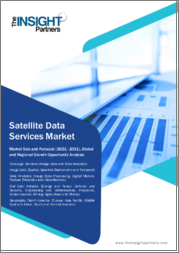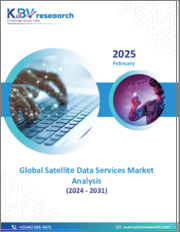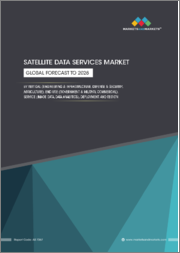
|
시장보고서
상품코드
1776852
세계의 위성 데이터 서비스 시장 평가 : 서비스별, 배포별, 최종 용도별, 지역별, 기회, 예측(2018-2032년)Global Satellite Data Services Market Assessment, By Service, By Deployment, By Application, By End-use, By Region, Opportunities and Forecast, 2018-2032F |
||||||
세계의 위성 데이터 서비스 시장 규모는 2024년 108억 8,000만 달러에서 2032년에 333억 2,000만 달러에 달할 것으로 예측되며, 2025-2032년의 예측 기간에 CAGR로 15.01%의 성장이 전망됩니다. 시장은 고해상도 지구관측과 실시간 지공간 인텔리전스에 대한 수요 증가로 인해 산업 전반에 걸쳐 큰 성장세를 보이고 있습니다. 합성개구부레이더(SAR)와 데이터 분석의 혁신으로 기능이 강화된 위성 데이터는 전략적, 상업적, 환경적 용도에 필수적인 요소로 자리매김하고 있습니다.
세계 기업이 디지털화를 채택함에 따라 고해상도 영상, 변화 감지, 예측 분석에 대한 수요가 증가하면서 농업, 재해 구호, 인프라 모니터링, 환경 모니터링, 국방 등의 분야에서 위성 기반 데이터 솔루션의 채택을 촉진하고 있습니다. 합성개구레이더(SAR), 다중 스펙트럼 영상, 하이퍼 스펙트럼 영상, AI를 활용한 분석과 같은 정교한 기술은 위성 데이터를 수집, 처리 및 제공하는 방식을 변화시키고 있습니다. 이를 통해 위성 데이터 서비스의 데이터 빈도, 정확도, 유용성을 획기적으로 향상시켜 중요한 의사결정 툴로 활용되고 있습니다. 위성의 소형화와 소규모 위성 콘스텔레이션의 도입으로 데이터 가용성을 크게 향상시키고 비용을 절감했습니다.
또한 우주항공 서비스에 대한 정부 투자 및 기업 지출도 기술 혁신과 투자가 부족한 분야로의 침투를 촉진하고 있습니다. 클라우드 컴퓨팅, AI, 가상 컨스테레션의 통합으로 시장은 상업용 원시 데이터 제공에서 거의 실시간으로 사용자에게 실용적인 인사이트를 제공하는 엔드투엔드 혁신 솔루션으로 진화하고 있습니다. 위성 영상은 이전부터 사용 가능했으나, 가용성과 정확도가 향상됨에 따라 다양한 산업에 미치는 영향은 더욱 심각해졌으며, 시장은 스마트 세계 인프라, 기후 변화에 대한 탄력성, 데이터베이스 의사결정의 핵심 촉진제가 될 것입니다.
세계의 위성 데이터 서비스 시장에 대해 조사분석했으며, 시장 규모와 예측, 시장 역학, 주요 기업의 상황 등을 제공하고 있습니다.
목차
제1장 프로젝트 범위와 정의
제2장 조사 방법
제3장 미국 관세의 영향
제4장 개요
제5장 고객의 소리
- 응답자 인구통계
- 브랜드 인지도
- 구입 결정에서 고려되는 요소
- 구입 후에 직면하는 과제
제6장 세계의 위성 데이터 서비스 시장 전망(2018-2032년)
- 시장 규모 분석과 예측
- 금액
- 시장 점유율 분석과 예측
- 서비스별
- 영상 데이터 서비스
- 데이터 애널리틱스 서비스
- 배포별
- 프라이빗
- 퍼블릭
- 하이브리드
- 용도별
- 방위, 보안
- 에너지, 유틸리티
- 농림
- 환경, 기후 모니터링
- 최종 용도별
- 상업
- 정부, 군대
- 서비스 프로바이더
- 지역별
- 북미
- 유럽
- 아시아태평양
- 남미
- 중동 및 아프리카
- 시장 점유율 분석 : 기업별(상위 5사와 기타)(금액)(2024년)
- 서비스별
- 시장 맵 분석(2024년)
- 서비스별
- 용도별
- 최종 용도별
- 지역별
제7장 북미의 위성 데이터 서비스 시장 전망(2018-2032년)
- 시장 규모 분석과 예측
- 금액
- 시장 점유율 분석과 예측
- 서비스별
- 영상 데이터 서비스
- 데이터 애널리틱스 서비스
- 배포별
- 프라이빗
- 퍼블릭
- 하이브리드
- 용도별
- 방위, 보안
- 에너지, 유틸리티
- 농림
- 환경, 기후 모니터링
- 최종 용도별
- 상업
- 정부, 군대
- 서비스 프로바이더
- 국가별
- 미국
- 캐나다
- 멕시코
- 서비스별
- 각국의 시장 평가
- 미국의 위성 데이터 서비스 시장 전망(2018-2032년)
- 시장 규모 분석과 예측
- 시장 점유율 분석과 예측
- 미국의 위성 데이터 서비스 시장 전망(2018-2032년)
제8장 유럽의 위성 데이터 서비스 시장 전망(2018-2032년)
- 독일
- 프랑스
- 이탈리아
- 영국
- 러시아
- 네덜란드
- 스페인
- 튀르키예
- 폴란드
제9장 아시아태평양의 위성 데이터 서비스 시장 전망(2018-2032년)
- 인도
- 중국
- 일본
- 호주
- 베트남
- 한국
- 인도네시아
- 필리핀
제10장 남미의 위성 데이터 서비스 시장 전망(2018-2032년)
- 브라질
- 아르헨티나
제11장 중동 및 아프리카의 위성 데이터 서비스 시장 전망(2018-2032년)
- 사우디아라비아
- 아랍에미리트
- 남아프리카공화국
제12장 Porter's Five Forces 분석
제13장 PESTLE 분석
제14장 시장 역학
- 시장 성장 촉진요인
- 시장이 해결해야 할 과제
제15장 시장 동향과 발전
제16장 사례 연구
제17장 경쟁 구도
- 시장 리더 상위 5사의 경쟁 매트릭스
- 상위 5사의 SWOT 분석
- 주요 기업 상위 10사의 상황
- Maxar Technologies Holdings Inc.
- Planet Labs PBC
- Airbus SAS
- ICEYE Oy
- L3Harris Technologies, Inc.
- Earth-i Ltd
- Geocento Limited
- NV5Global, Inc.
- Satellite Imaging Corporation
- SATPALDA
제18장 전략적 제안
제19장 조사회사 소개·면책사항
KSA 25.08.04Global satellite data services market is projected to witness a CAGR of 15.01% during the forecast period 2025-2032, growing from USD 10.88 billion in 2024 to USD 33.32 billion in 2032. The global satellite data services market is witnessing significant growth, driven by increasing demand for high-resolution Earth observation and real-time geospatial intelligence across industries. Innovations in synthetic aperture radar (SAR) and data analytics are enhancing capabilities, making satellite data essential for strategic, commercial, and environmental applications.
As businesses worldwide adopt digital change, demand for high-resolution images, change detection, and predictive analysis has increased, driving adoption of satellite-based data solutions in agriculture, disaster relief, infrastructure monitoring, environmental monitoring, defense, and other applications. Sophisticated technologies such as Synthetic Aperture Radar (SAR), multispectral and hyperspectral imagery, and AI-enabled analytics are transforming the way satellite data is collected, processed, and served. This has dramatically enhanced data frequency, accuracy, and usefulness of satellite data services, rendering them key decision-making tools. Miniaturization of satellites and the implementation of small satellite constellations have also greatly enhanced data availability and reduced costs.
Furthermore, government investments and business expenditure on space-based services are also driving innovation and penetration into under-invested areas. With the integration of cloud computing, artificial intelligence, and virtual constellations, the market is evolving from end-to-end innovative solutions, from commercial raw data delivery to the delivery of actionable insights to users in near real-time. Although satellite imagery has been available for some time, its enhanced availability and accuracy would make its impact on multiple industries more profound, rendering the market the core facilitator of smart world infrastructure, climate resilience, and data-driven decision-making.
Rising Demand for Earth Observation in Environmental Monitoring Drives Market Growth
The increase in frequency and intensity of climate-driven events, such as floods, wildfires, and hurricanes, has driven up demand for satellite data services worldwide. Earth observation satellites provide timely and valuable information that governments, NGOs, and non-governmental organizations rely on for environmental monitoring, disaster prediction, and emergency planning. Synthetic Aperture Radar (SAR) and satellite imagery are exceptionally vital for collecting terrain information, tracking forest cover loss trends, monitoring sea level rise, and assessing agricultural land use. For example, Planet Labs entered into a three-year agreement with the German Space Agency at the German Aerospace Center in September 2024 to provide Earth observation data and image products. This collaboration enables German researchers to leverage the high-resolution monitoring capabilities of PlanetScope and its extensive imagery resources in direct support of research and development applications for environmental monitoring and climate change adaptation.
This growing dependence on satellite-based environmental intelligence will drive steady growth in the satellite data services market. The requirement for timely, precise, and affordable geospatial intelligence is becoming an integral aspect of international environmental regulation and disaster recovery planning, all the more so. Furthermore, as government and private investment extends to satellite constellations dedicated to climate resilience, satellite data services will continue to be a foundation of global sustainability and scientific advancement initiatives.
Expansion of Commercial Applications and Strategic Industry Partnerships Propels the Market
Beyond environmental uses, satellite data services are expanding exponentially, driven by increasing commercial uses across maritime, agriculture, logistics, finance, and infrastructure management sectors. Businesses increasingly rely on near real-time spatial intelligence to make better decisions, track assets, optimize operations, and enhance risk management measures. For instance, in August 2024, Botswana's Civil Aviation Authority partnered with the Azerbaijani space agency, Azercosmos, to offer satellite data services via the Azerspace-1 telecommunication satellite. This is the very first time Botswana has benefited from satellite data via the African C-band coverage of the satellite. The cooperation aims to enhance Botswana's capabilities in aviation management, communication, and broader commercial use, reflecting the trend among developing economies to adopt satellite solutions for enabling critical infrastructure and commercial services.
As companies integrate geospatial intelligence with big data analytics and artificial intelligence, satellite data becomes a key enabler of risk management and business agility. The increasing number of government-commercial collaborations and border-spanning partnerships indicates a shift toward greater utility and access to satellite data in commercial economies. This is transforming satellite data services from a traditional government-owned asset to an enterprise-critical infrastructure for global economies.
Commercial Segment Holds the Largest Global Satellite Data Services Market Share
The business division is being established as the leading satellite data services company in the global marketplace, driven by the growth momentum of data-intensive applications across industry verticals, including agriculture, energy, mining, finance, logistics, and insurance. Data analytics and satellite imagery are fundamental to companies today, whose reliance on these tools is leveraged to drive business productivity, track assets, evaluate risk, and support strategic decision-making. The increasing dependence on high-definition, real-time geospatial information is driving demand for commercial satellite data services. For instance, in November 2024, Spire Global's Automatic Identification System (AIS) ship-tracking business bought by Kpler for USD 241 million. Global data intelligence company Kpler utilizes Spire's maritime data to enhance its shipping and trade analytics. This transaction highlights the growing importance that commercial operators now place on information derived from satellites, ranging from fleet tracking to commodity trade and supply chain optimization.
Business customers are also utilizing large-scale satellite services due to increased access to data via APIs, analysis tools that can be customized to place orders, and improved access to SaaS-based Earth observation services. Besides, sectors such as precision agriculture and renewable energy are incorporating satellite data on their platforms to enhance yield prediction, site evaluation, and infrastructure tracking. Funds from private capital are flowing into satellite start-ups, and public-private collaborations are flourishing; as a result, the commercial market will continue to lead the way. Its capacity to capitalize on satellite intelligence and turn it into viable, scalable business solutions is driving it towards becoming the industry's growth and innovation leader.
North America Leads the Global Satellite Data Services Market
North America is the leading player in the global satellite data services market, driven by its robust space infrastructure, government investment, and robust commercial space business ecosystem. It is complemented by the high engagement of federal bodies, such as NASA, NOAA, and the U.S. Department of Defense, which greatly depend on satellite data for earth observation, climate monitoring, defense intelligence, and disaster management. Aside from that, North America also boasts leading satellite data suppliers like Maxar Technologies, Planet Labs, and Spire Global.
One clear example of North American leadership is NASA's September 2024 decision to award ICEYE US a five-year contract to supply synthetic aperture radar (SAR) data under the agency's Commercial Smallsat Data Acquisition Program. This is happening at a time that highlights the region's emphasis on utilizing commercial satellite capacity to advance national scientific and research interests. Moreover, higher private sector collaborations, venture capital investment in satellite start-ups, and rapid technology boom in SAR and hyperspectral technologies are further solidifying North America's lead. The region's excellent regulatory environment and conducive innovation ecosystem offer continuous improvements in the delivery of satellite data, analysis, and integration, making it a hub for both local and international customers seeking reliable geospatial intelligence.
Impact of U.S. Tariffs on Global Satellite Data Services Market
Even as technology and alliances are the cornerstones of the global satellite data services market, U.S. tariffs can indirectly impact its growth trajectory. Tariffs on electronics, semiconductors, or aerospace products from primary suppliers such as China could increase the production costs for satellite firms and private data services firms. These extra costs can trickle down to commercial customers, lowering the adoption rate in price-sensitive segments.
Moreover, geopolitical disputes and trade embargoes may compromise global supply chains, slow satellite launches, or restrict access to critical imaging technologies. This may hit particularly multinational partnerships that depend on U.S. based satellite infrastructure or software. Nevertheless, U.S. superiority in the satellite space usually balances such threats through local acquisition and robust innovation pipelines. Nonetheless, global players must proceed with caution when navigating these tariff-related uncertainties, particularly when dealing with U.S. counterparts or sourcing U.S.-based components and technologies.
Key Players Landscape and Outlook
Global satellite data services market is massively fragmented, with new and established players competing to provide high-resolution imagery, advanced analytics, and real-time data products. The players span various sectors, including agriculture, defense, climate monitoring, and infrastructure, utilizing their satellite constellations and processing infrastructure to deliver tailored services. Fragmentation creates the catalyst for innovation, where players compete to enhance the quality of imagery, reduce data turnaround time, and increase usage areas.
Even the bigger players, such as Planet Labs, ICEYE, and Spire Global, have also made remarkable progress in recent years. For example, in June 2024, Japan's NEC Corporation partnered with Ursa Space Systems to offer satellite imagery interpretation via a "virtual constellation" approach. The project utilizes a constellation of optical and SAR satellites to deliver end-to-end data on various industries like disaster management, infrastructure monitoring, and environmental studies, in line with the industry trend toward multi-source, integrated data platforms.
In the coming years, the market is expected to expand steadily as governments, corporate businesses, and non-governmental organizations continue to rely on satellite data for informed business decisions. They must source providers who can provide scalable solutions, global access, and artificial intelligence-driven analytics. Further, commercial organizations and government space agencies will form collaborative arrangements to expedite development and incorporate high-quality data. As local players grow and consolidation becomes inevitable in the foreseeable future, the competitive landscape will remain dynamic, presenting both threats and opportunities for incumbent companies and new entrants.
Table of Contents
1. Project Scope and Definitions
2. Research Methodology
3. Impact of U.S. Tariffs
4. Executive Summary
5. Voice of Customers
- 5.1. Respondent Demographics
- 5.2. Brand Awareness
- 5.3. Factors Considered in Purchase Decisions
- 5.4. Challenges Faced Post Purchase
6. Global Satellite Data Services Market Outlook, 2018-2032F
- 6.1. Market Size Analysis & Forecast
- 6.1.1. By Value
- 6.2. Market Share Analysis & Forecast
- 6.2.1. By Service
- 6.2.1.1. Image Data Service
- 6.2.1.2. Data Analytics Service
- 6.2.2. By Deployment
- 6.2.2.1. Private
- 6.2.2.2. Public
- 6.2.2.3. Hybrid
- 6.2.3. By Application
- 6.2.3.1. Defense and Security
- 6.2.3.2. Energy and Utilities
- 6.2.3.3. Agriculture and Forestry
- 6.2.3.4. Environmental and Climate Monitoring
- 6.2.4. By End-use
- 6.2.4.1. Commercial
- 6.2.4.2. Government and Military
- 6.2.4.3. Service Providers
- 6.2.5. By Region
- 6.2.5.1. North America
- 6.2.5.2. Europe
- 6.2.5.3. Asia-Pacific
- 6.2.5.4. South America
- 6.2.5.5. Middle East and Africa
- 6.2.6. By Company Market Share Analysis (Top 5 Companies and Others - By Value, 2024)
- 6.2.1. By Service
- 6.3. Market Map Analysis, 2024
- 6.3.1. By Service
- 6.3.2. By Application
- 6.3.3. By End-use
- 6.3.4. By Region
7. North America Satellite Data Services Market Outlook, 2018-2032F
- 7.1. Market Size Analysis & Forecast
- 7.1.1. By Value
- 7.2. Market Share Analysis & Forecast
- 7.2.1. By Service
- 7.2.1.1. Image Data Service
- 7.2.1.2. Data Analytics Service
- 7.2.2. By Deployment
- 7.2.2.1. Private
- 7.2.2.2. Public
- 7.2.2.3. Hybrid
- 7.2.3. By Application
- 7.2.3.1. Defense and Security
- 7.2.3.2. Energy and Utilities
- 7.2.3.3. Agriculture and Forestry
- 7.2.3.4. Environmental and Climate Monitoring
- 7.2.4. By End-use
- 7.2.4.1. Commercial
- 7.2.4.2. Government and Military
- 7.2.4.3. Service Providers
- 7.2.5. By Country
- 7.2.5.1. United States
- 7.2.5.2. Canada
- 7.2.5.3. Mexico
- 7.2.1. By Service
- 7.3. Country Market Assessment
- 7.3.1. United States Satellite Data Services Market Outlook, 2018-2032F
- 7.3.1.1. Market Size Analysis & Forecast
- 7.3.1.1.1. By Value
- 7.3.1.2. Market Share Analysis & Forecast
- 7.3.1.2.1. By Service
- 7.3.1.2.1.1. Image Data Service
- 7.3.1.2.1.2. Data Analytics Service
- 7.3.1.2.2. By Deployment
- 7.3.1.2.2.1. Private
- 7.3.1.2.2.2. Public
- 7.3.1.2.2.3. Hybrid
- 7.3.1.2.3. By Application
- 7.3.1.2.3.1. Defense and Security
- 7.3.1.2.3.2. Energy and Utilities
- 7.3.1.2.3.3. Agriculture and Forestry
- 7.3.1.2.3.4. Environmental and Climate Monitoring
- 7.3.1.2.4. By End-use
- 7.3.1.2.4.1. Commercial
- 7.3.1.2.4.2. Government and Military
- 7.3.1.2.4.3. Service Providers
- 7.3.1.2.1. By Service
- 7.3.1.1. Market Size Analysis & Forecast
- 7.3.1. United States Satellite Data Services Market Outlook, 2018-2032F
All segments will be provided for all regions and countries covered
8. Europe Satellite Data Services Market Outlook, 2018-2032F
- 8.1. Germany
- 8.2. France
- 8.3. Italy
- 8.4. United Kingdom
- 8.5. Russia
- 8.6. Netherlands
- 8.7. Spain
- 8.8. Turkey
- 8.9. Poland
9. Asia-Pacific Satellite Data Services Market Outlook, 2018-2032F
- 9.1. India
- 9.2. China
- 9.3. Japan
- 9.4. Australia
- 9.5. Vietnam
- 9.6. South Korea
- 9.7. Indonesia
- 9.8. Philippines
10. South America Satellite Data Services Market Outlook, 2018-2032F
- 10.1. Brazil
- 10.2. Argentina
11. Middle East and Africa Satellite Data Services Market Outlook, 2018-2032F
- 11.1. Saudi Arabia
- 11.2. UAE
- 11.3. South Africa
12. Porter's Five Forces Analysis
13. PESTLE Analysis
14. Market Dynamics
- 14.1. Market Drivers
- 14.2. Market Challenges
15. Market Trends and Developments
16. Case Studies
17. Competitive Landscape
- 17.1. Competition Matrix of Top 5 Market Leaders
- 17.2. SWOT Analysis for Top 5 Players
- 17.3. Key Players Landscape for Top 10 Market Players
- 17.3.1. Maxar Technologies Holdings Inc.
- 17.3.1.1. Company Details
- 17.3.1.2. Key Management Personnel
- 17.3.1.3. Key Products/Services Offered
- 17.3.1.4. Key Financials (As Reported)
- 17.3.1.5. Key Market Focus and Geographical Presence
- 17.3.1.6. Recent Developments/Collaborations/Partnerships/Mergers and Acquisition
- 17.3.2. Planet Labs PBC
- 17.3.3. Airbus SAS
- 17.3.4. ICEYE Oy
- 17.3.5. L3Harris Technologies, Inc.
- 17.3.6. Earth-i Ltd
- 17.3.7. Geocento Limited
- 17.3.8. NV5 Global, Inc.
- 17.3.9. Satellite Imaging Corporation
- 17.3.10. SATPALDA
- 17.3.1. Maxar Technologies Holdings Inc.
Companies mentioned above DO NOT hold any order as per market share and can be changed as per information available during research work.



















